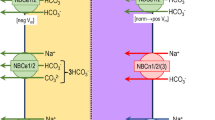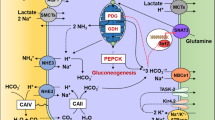Summary
The excretion of cationic compounds by renal proximal tubule cells involves at least two distinct transporters: the basolateral type which transports organic cations from the plasma into the proximal tubule cell, and the apical type which secretes the organic cations into the lumen of the tubule. However, potent inhibitors were known for neither type of transporter. Here we introduce a compound, decynium22, that potently, competitively, and selectively inhibits the apical type of the renal organic cation transporter.
The transport of the prototypical organic cation 14C-tetraethylammonium through the apical plasma membrane of clonal proximal tubule cells (LLC-PK1) was used as experimental system. Initial rates of 14C-tetraethylammonium transport into LLC-PK1 cells were saturable, the Km and Vmax being 27 μmol/l and 200 pmol/(mg protein · min), respectively. Decynium 22 competitively and potently inhibited 14C-tetraethylammonium transport (Ki = 5.6 nmol/l). Moreover, the effect of decynium22 on basolateral to apical directed transepithelial transport of 14C-tetraethylammonium through a confluent monolayer of LLC-PK1 cells was determined. Decynium22 (30 nmol/l) applied to the apical medium, reduced transepithelial transport by 76% and increased intracellular accumulation of 14C-tetraethylammonium 1.5-fold. In contrast, application of 30 nmol/l decynium22 to the basolateral medium failed to affect transepithelial transport and intracellular accumulation of 14C-tetraethylammonium.
Decynium22 is the most potent inhibitor of the renal transport of organic cations known so far. With decynium22 it is now possible to distinguish precisely between a decynium22-sensitive apical type and a decynium22-resistant basolateral type of renal organic cation transporter in renal proximal tubule cells.
Similar content being viewed by others
References
Babin-Ebell J, Russ H, Gliese M, Schömig E (1991) Inhibition of the renal transport system for organic cations by steroids. Naunyn-Schmiedeberg's Arch Pharmacol [Suppl] 343:R92
Cheng YC, Prusoff WH (1973) Relationship between the inhibition constant (Ki) and the concentration of inhibitor which causes 50 per cent inhibition (IC50) of an enzymatic reaction. Biochem Pharmacol 22:3099–3180
Gillespie JS (1976) Extraneuronal uptake of catecholamines in smooth muscle and connective tissue: In: Paton DM (ed) The mechanims of neuronal and extraneuronal transport of catecholamines. Raven Press, New York, pp 325–354
Hay R, Macy M, Chen TR, MacClintoc P, Reid Y (1988) American type culture collection catalogue of cell lines and hybridomas, 6th edn. American type culture collection, Rockville, Md., USA
Holohan PD, Ross CR (1981) Mechanisms of organic cation transport in kidney plasma membrane vesicles: 2. pH-studies. J Pharmacol Exp Ther 216:294–298
Iversen LL (1965) The uptake of catechol amines at high perfusion concentrations in the rat isolated heart: A novel catechol amine uptake process. Br J Pharmacol 25:18–33
Jung JS, Kim YK, Lee SH (1989) Characteristics of tetraethylammonium transport in rabbit renal plasma-membrane vesicles. Biochem J 259:377–383
Lowry OH, Rosenbrough NJ, Farr AL, Randall RJ (1951) Protein measurement with the Folin phenol reagent. J Biol Chem 193:265–275
McKinney TD, DeLeon C, Speeg KV (1988) Organic cation uptake by a cultured renal epithelium. J Cell Physiol 137:513–520
Rabito CA (1986) Occluding junctions in a renal cell line (LLC-PK1) with characteristics of proximal tubular cells. Am J Physiol 250:F734–743
Rafizadeh C, Roch-Ramel F, Schäli C (1987) Tetraethylammonium transport in renal brush border membrane vesicles of the rabbit. J Pharmacol Exp Ther 240:308–313
Rennick BR (1981) Renal tubular transport of organic cations. In: Greger R, Lang F, Silbernagl S (eds) Renal transport of organic substances. Springer, Berlin Heidelberg New York, pp 178–188
Rennick BR, Kandel A, Peters L (1956) Inhibition of the renal tubular excretion of tetraethylammonium and N′-methylnicotinamide by basic cyanine dyes. J Pharmacol Exp Ther 118:204–219
Russ H, Engel W, Sonna J (1992) Cyanine-derived dyes as a novel class of potent inhibitors of extraneuronal noradrenaline transport (uptake2). Naunyn-Schmiedeberg's Arch Pharmacol [Suppl]345:R103
Schömig E, Schbnfeld C-L (1990) Extraneuronal noradrenaline transport (uptake2) in a human cell line (Caki-1 cells). Naunyn-Schmiedeberg's Arch Pharmacol 341:404–410
Segel IH (1975) Enzyme kinetics: Behavior and analysis of rapid equilibrium and steady-state enzyme systems. John Wiley, New York London Sydney Toronto
Sokol PP, Holohan PD, Grass SM, Ross CR (1988) Proton-coupled organic cation transport in renal brush-border membrane vesicles. Biochim Biophys Acta 940:209–218
Takano M, Inui K-I, Okano T, Saito H, Hori R (1984) Carrier-mediated transport systems of tetraethylammonium in rat renal brush-border and basolateral membrane vesicles. Biochim Biophys Acta 773:113–124
Trendelenburg U (1988) The extraneuronal uptake and metabolism of catecholamines. In: Trendelenburg U, Weiner N (eds) Catecholamines I. (Handb Exp Pharmacol, vol 90). Springer, Berlin Heidelberg New York London Tokyo, pp 279–319
Ullrich KJ, Papavassiliou F, David C, Rumrich G, Fritzsch G (1991) Contraluminal transport of organic cations in the proximal tubule of the rat kidney. I. Kinetics of N1-methylnicotinamide and tetraethylammonium, influence of K+, HCO3 −, pH; inhibition by aliphatic primary, secondary and tertiary amines and mono- and bisquartenary compounds. Pflüger's Arch 419:84–92
Weiner IM (1985) Organic acids and bases and uric acid. In: Seldin DW, Giebisch G (eds) The kidney: physiologgy and pathophysiology. Raven Press, New York, pp 1703–1724
Wilkinson L (1989) SYSTAT The system for statistics. SYSTAT Inc., Evanston, Ill., USA
Wright SH, Wunz TM (1987) Transport of tetraethylammonium by rabbit renal brush-border and basolateral membrane vesicles. Am J Physiol 253:F1040-F1050
Author information
Authors and Affiliations
Additional information
Supported by the Deutsche Forschungsgemeinschaft (SFB176) and the Universitätsbund Würzburg
Correspondence to E. Schömig at the above address
Rights and permissions
About this article
Cite this article
Schömig, E., Babin-Ebell, J. & Russ, H. 1,1′-Diethyl-2,2′-cyanine (decynium22) potently inhibits the renal transport of organic cations. Naunyn-Schmiedeberg's Arch Pharmacol 347, 379–383 (1993). https://doi.org/10.1007/BF00165387
Received:
Accepted:
Issue Date:
DOI: https://doi.org/10.1007/BF00165387




